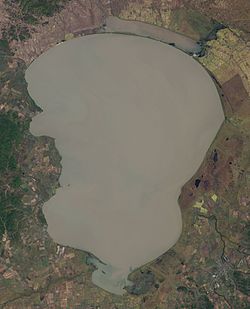Lake Khanka
| Lake Khanka Lake Xingkai о́зеро Ха́нка 兴凯湖 |
|
|---|---|

Landsat 7 image (2001)
|
|
| Location | Primorsky Krai, Russia / Heilongjiang, China |
| Coordinates | 45°0′N 132°25′E / 45.000°N 132.417°ECoordinates: 45°0′N 132°25′E / 45.000°N 132.417°E |
| Primary outflows | Songacha River |
| Basin countries | People's Republic of China, Russia |
| Max. length | 90 km (56 mi) |
| Max. width | 45 km (28 mi) |
| Surface area | 4,070 km2 (1,570 sq mi) |
| Average depth | 4.5 m (15 ft) |
| Max. depth | 10.6 m (35 ft) |
| Water volume | 18.3 km3 (4.4 cu mi) |
| Residence time | 9.9 yrs |
| Shore length1 | 308 km (191 mi) |
| Surface elevation | 68 m (223 ft) - 70 m (230 ft) |
| Frozen | December–April |
| Designated | October 12, 1974 |
| 1 Shore length is not a well-defined measure. | |
Lake Khanka (Russian: о́зеро Ха́нка) or Lake Xingkai (simplified Chinese: 兴凯湖; traditional Chinese: 興凱湖; pinyin: Xīngkǎi Hú), is a freshwater lake located on the border between Primorsky Krai, Russia and Heilongjiang province, Northeast China (at 45°0′N 132°25′E / 45.000°N 132.417°E).
On the Delil map of 1706, the lake is named Himgon and from it flows a river with two signatures - Usurou and Ousuri.
On the map of IM Khasii (German Johannes Matthiæ Hasii, (1684-1742) 1739, the river flowing from Lake Hinka is called Ousoury and Schur.
On the map of de'Anville, in 1752, the lake also has the name Hink, but from the lake the Songhachan River flows into Usuri.
On the map of the XVIII century "Irkutsk governorate with the adjacent islands and the western coast of America" from Lake Hinka follows the river Usuri.
On the map of 1860, attached to the Convention of Peking, two lakes are shown: the large "Oz. Khankai "with the second signature" Quiet ", but without the Manchu signatures, and a small lake" Oz. Dobiku "with the Manchurian signature. From the big lake flows a river, which has two signatures in Russian: "Uzhu" and "Sungachan", the second name has a signature in the Manchu language.
On the map of M. Popov in 1861, a large lake is called "Kengka" and the small one is called "Ai'-Kengka" and Siauhu is added in brackets, which can be understood as the transcription of the Chinese Xiaohu, that is, the Small Lake.
...
Wikipedia
